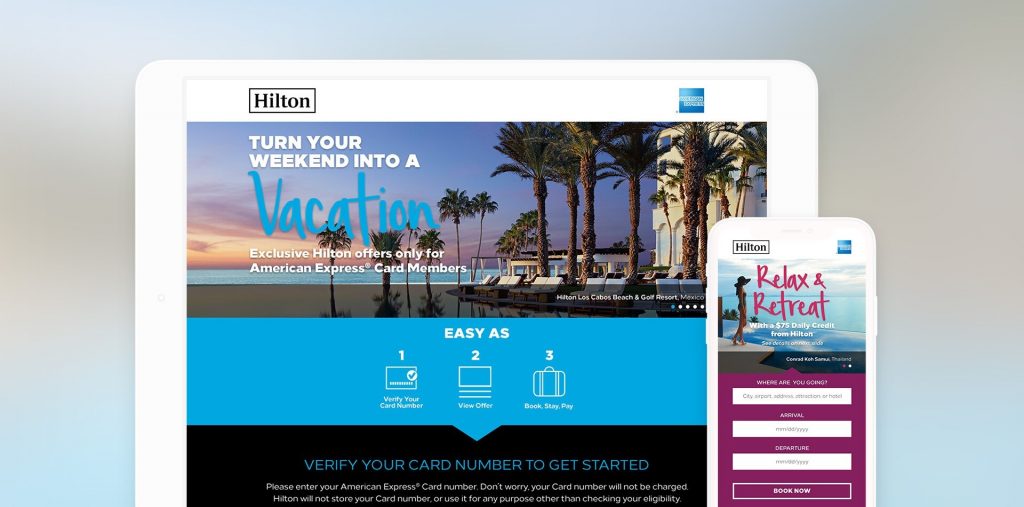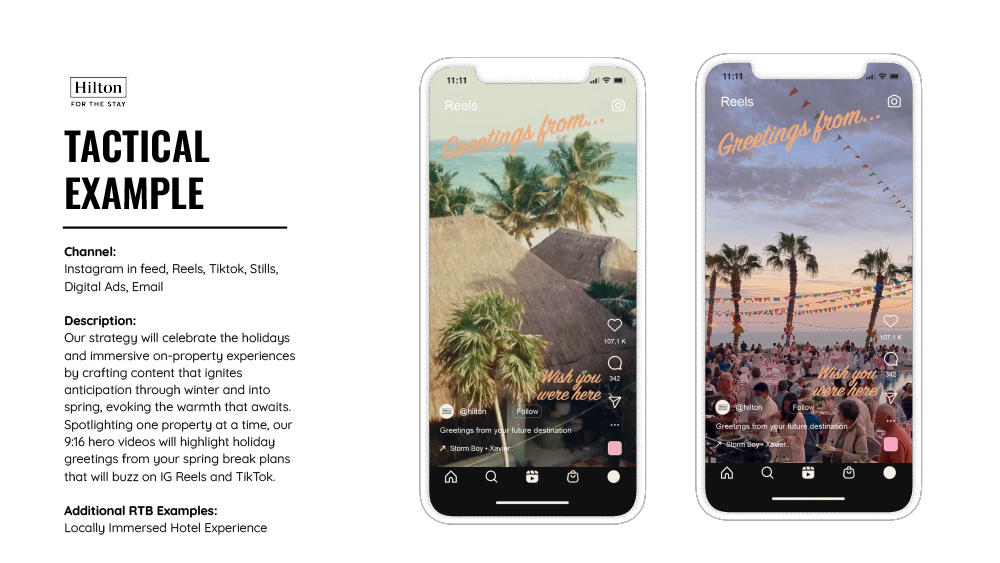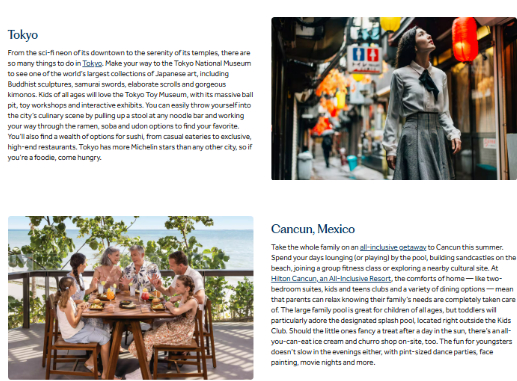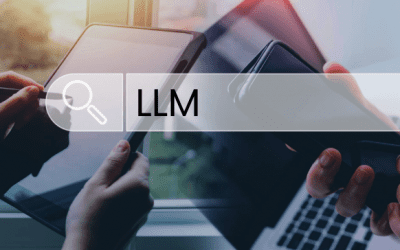In an increasingly competitive environment, landing pages are far more than a digital business card: they are a key driver of conversion, engagement, and brand positioning. Hilton, one of the most globally recognized hotel chains, has developed a digital strategy focused on efficiency, personalization, and trust. In this analysis, we break down its main features, comparing them to other leading brands in the tourism and airline industries to extract insights and best practices.
Design and Usability: Clear Structure and Accessibility Above All
The first visual impression of Hilton’s landing pages conveys order and professionalism. A modular structure prevails, clearly guiding the user: well-organized headings, clean images, simple icons, and clearly differentiated call-to-action buttons.
Key elements:
- Responsive modular design, adaptable to all devices, with a mobile experience that maintains full functionality compared to desktop.
- Use of high contrast and accessible typography, even for visually impaired users.
- Sticky header that keeps access to the main menu, including the stay search bar and Hilton Honors login.

Compared to airlines like Emirates or Iberia, which adopt a more emotional and visual aesthetic with animated sliders, Hilton prioritizes a more functional experience. This decision makes sense from a conversion standpoint: fewer distractions, more focus on the goal.
However, in promotional landings (such as romantic getaways or family vacations), Hilton has begun incorporating more visual and sensory elements—albeit subtly.
Conversion Strategies: An Optimized Funnel at Every Step
Hilton effectively applies the principles of conversion marketing. Its funnel is designed to minimize friction and speed up decision-making. From the first screen, the user can start a booking without needing to explore other sections.
Tactics used:
- Consistent and visible CTAs such as “Book Now” or “Redeem Points,” always highlighted with high-contrast colors.
- Urgency or scarcity elements like “Only 3 rooms left at this property” or “Today only: exclusive deal,” which improve click-through rate.
- Simplified single-page forms with instant validation and autofill options for returning members.
Compared to other chains like Accor or RIU, Hilton stands out for reducing process complexity and emphasizing the perceived value of its loyalty program. Each navigation step is carefully designed to keep users focused and reduce drop-offs.
Storytelling and Visual Content: Balancing Aspirational and Practical
Visual content at Hilton serves a dual function: to inform and to communicate quality. The images are carefully selected to reflect not only the facilities but also the type of experience one can expect.
Best practices observed:
- Use of real images (rooms, services, common areas) with high resolution and natural staging.
- In some campaigns, short videos highlight experiences like spas, rooftop views, or outdoor breakfasts.
- Emotionally charged copy is moderate but effective in select campaigns with lines like: “Make every moment unforgettable” or “Your perfect escape away from home.”
Brands like Four Seasons or airlines like Qatar Airways go further in storytelling, crafting full narrative pieces. Hilton, by contrast, maintains a more sober and trustworthy tone, appealing to efficiency and safety—especially valued by business travelers.
Integration with Social Media and Digital Campaigns
While Hilton doesn’t excessively showcase social media buttons, it does implement effective integration with its digital campaigns. This is reflected in both tracking and message consistency across channels.
Strategies observed:
- Dynamic remarketing campaigns with personalized offers after visiting specific landings.
- Collaborations with travel and lifestyle influencers who drive traffic from Instagram to thematic landing pages.
- In certain campaigns, use of real user testimonials, even with visual user-generated content as social proof.

Compared to airlines like Ryanair or Wizz Air, which favor viral or humorous content, Hilton maintains a more institutional approach—though it knows how to leverage key moments like Black Friday or Valentine’s Day to expand social reach.
Personalization and Segmentation: Content Tailored to the User
Personalization is one of the pillars of Hilton’s digital marketing strategy. From the moment users access the site, their location is detected and part of the content is adapted to their language, currency, and region.
Clear examples of personalization:
- Localized offers such as “Hotels near you” or region-specific promotions triggered by IP.
- Recommendations based on previous searches, especially when the user is logged into Hilton Honors.
- Contextual messages like “Welcome back, Laura. Ready for your next coastal getaway?”
Compared to other hotel chains, Hilton goes a step further in combining contextual data (geolocation) and behavioral data (previous navigation) to personalize the real-time experience. This approach boosts conversion rates and strengthens the perception of a brand that is close and relevant.

In this area, solutions like Smartvel can further enhance personalization on landing pages by integrating dynamic, hyper-local content tailored to each user. Displaying up-to-date plans, events, experiences, or places of interest near the hotel—based on the visitor’s profile or location—turns a simple booking page into a useful and inspiring touchpoint, aligned with the expectations of today’s digital traveler.
Applied Web Design Trends: Simplicity, Microinteractions, and Mobile-First
Hilton has adopted many of the leading web design trends in the tourism sector, combining functional aesthetics with micro-experiences that elevate interaction.
Current trends present:
- Visual minimalism with effective use of white space.
- Smooth animations and microinteractions such as responsive buttons and real-time form validation.
- Adaptive design that prioritizes mobile navigation, with easy-to-use gestures, fluid scrolling, and progressive image loading.
The mobile experience, in particular, is one of Hilton’s strengths. Everything is designed to be navigable with one hand, especially useful for on-the-go bookings. This is comparable to airlines like Lufthansa or Delta, which also prioritize well-optimized mobile environments.
SEO, SEM and Performance Analysis: Hilton Leads in Branded and Destination Searches
Hilton maintains a mature SEO strategy based on evergreen content, destination-specific landing pages, and smart use of internal linking. According to Sistrix data, Hilton’s visibility index remains stable, with growth in long-tail keywords such as “Hilton hotel downtown Prague” or “family hotel in Cancun with breakfast.”
Actions observed:
- On-page SEO optimization with well-structured titles, meta descriptions, and H1 tags.
- Clean, canonical URLs optimized for combined brand and location searches.
- Well-segmented SEM campaigns, especially for branded keywords and opportunities versus OTAs.
Technology and Innovation: Features That Anticipate User Needs
While Hilton isn’t known for experimenting with cutting-edge tech on all its landing pages, it has implemented innovative tools that improve interaction and convey a modern, reliable brand image.
Technologies applied:
- AI-powered chatbots to answer questions, change dates, or suggest alternative hotels.
- Online check-in integrated via specific landing pages, especially for urban properties.
- 360º viewers or virtual tours in select premium properties.
- Virtual assistants for reservation management through mobile apps or Alexa Skills.
In the future, it would be interesting to see Hilton explore augmented reality to showcase rooms or offer gamified experiences on landing pages, as Marriott has already done in some campaigns.
Conclusion: Hilton, Digital Efficiency With Room for the Aspirational
Hilton has built a digital ecosystem that prioritizes efficiency, clarity, and personalization—without abandoning emotional appeal altogether. Its landing pages are technically robust, user-centered, and consistent with its brand proposition: trust, consistency, and added value for the modern traveler.
While there is room for improvement in emotional storytelling and immersive experiences, Hilton positions itself as a benchmark in usability, conversion, and digital strategy within the hotel industry.






